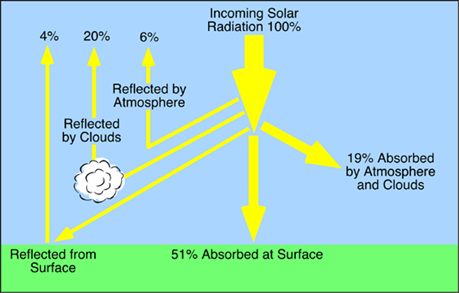Solar Radiation: Or Smoke and Mirrors?
Sunlight is important for photosynthesis and carbohydrate production. The wildfires across Canada have caused a week of hazy overcast weather in the early V1-V6 stage. Reduced light intensity and increased ozone levels are two main factors that affect corn and soybean photosynthesis and may be impacted by the wildfires. This brings to question whether the intense cloud cover we have experienced over the past week will cause lasting effects on this year’s corn and soybean crop.
Firstly, it is important to understand where does our light go? 51% of solar radiation is absorbed at the Earth’s surface, 19% is absorbed by atmosphere and clouds and 30% is reflected from either the earth’s surface, clouds, or the atmosphere. Much like a cloud cover, smoke can reflect a portion of the incoming sunlight which reduces the amount of sunlight that reaches the Earth’s surface and therefore reduces the light available to plants. This can result in problems as corn is susceptible to reduced yields and reduced standability if the plants need to remobilize carbohydrates from the stalk to make up for a deficit in photosynthesis.

That being said, if this haze persists, what can we expect?
That depends on how long the smoke sticks around. If you are only seeing hazy conditions for a week, that probably won’t be enough time to really delay maturity or reduce the yield of most crops. However, if these smoky conditions persist for 3 or 4 weeks, we may see possible kernel reductions at critical growth stages and a delayed R stage.
One benefit from the smoke is the reduction in heat that this smoke has been creating. This is because we don’t get as much direct sunlight since the light can’t penetrate the smoke, resulting in the slightly cooler temperatures we have been experiencing this week. This has been slightly beneficial since it has been quite dry since planting this season. However, this also brings to the forefront some potential issues with N mineralization this season.
N Mineralization is the decomposition of organic N (manure/organic matter/residue). N mineralization occurs most abundantly with adequate soil moisture and typically at 20 C- 35 C. Given the cooler temperatures this spring, and lack of moisture, PSNT may be below average this spring. This means it is going to be critical to ensure timely and accurate applications of N to the crop to be sure we maintain grainfill/stalks late season.
Again, lasting effects will depend on the thickness or the haze and how long it persists. So, while there is not much we can do to avoid the effects of these smoky conditions, fortunately, reductions in solar radiation during silking and grain fill have a much greater impact than the same level of reduction prior to silking (Liu and Tollenaar, 2009; Reed et al., 1988).
Let’s hope that the opportunity for rain this weekend will help us catch a break in the smoke and allow for us to get in the field for a timely nitrogen application to keep our crop growing and healthy for the remainder of the growing season.
References
Liu, W. and M. Tollenaar, 2009. Physiological mechanisms underlying heterosis for shade tolerance in maize. Crop Sci. 49:1817–1826.
Reed, A., G. Singletary, J. Schussler, D. Williamson and A. Christy, 1988. Shading effects on dry matter and nitrogen partitioning, kernel number, and yield of maize. Crop Sci. 28: 819–825.

